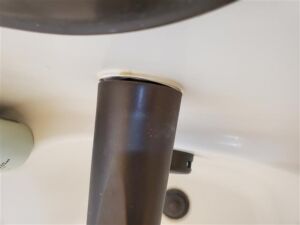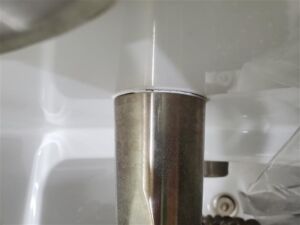
Most faucets screw into a threaded pipe or fitting in the wall. Similarly, valve handles are generally screwed on and comprise multiple components that are fastened to the shower enclosure. When faucets and other fixture components are not properly set against the shower enclosure a gap can be left. The gaps are often sealed using caulk. Over time caulk will deteriorate causing an area that is susceptible to moisture intrusion.
Water from bathing activities that makes its way behind the shower enclosure can cause various problems. Over time this moisture can damage the wall framing, cause the development of microbial growth and mold, and even make its way down to the floor assembly. Because the area behind a shower enclosure is not visible, moisture or mold issues can go unnoticed until significant damage has occurred. Moisture damage to walls and floors can be very expensive and mold growth can cause a variety of health concerns, including respiratory issues and worsening of existing conditions, such as asthma.
Luckily, this is typically an easy fix that can be accomplished by a homeowner using materials that can be purchased at most hardware stores. A silicone-based caulk can be applied to the open gap to provide a seal. This method of repair is advised for gaps that are ½-inch or smaller. Silicone-based sealants are more durable than standard caulk. The flexibility of the silicone allows it to last longer in areas with higher moisture and it tends not to crack. You should make sure not to caulk the very bottom of a faucet because if it were to leak at its base it would enter the wall assembly and go unnoticed.

Large gaps between fixtures and shower enclosures may also be the result of poor installation. The faucet may not have been properly screwed onto the distribution pipe. If the faucet feels loose when a small amount of pressure is applied, the faucet may need to be re-set onto the pipe. Having a loose faucet could cause damage to the pipe, fitting, or fixture if human caused impact were to occur. A loose faucet may also be the result of a damaged or worn-out fitting.
Replacing a fitting or re-setting a faucet can also be done by a homeowner. Faucets can often be removed by taking out a set screw or rotating the faucet counterclockwise. Fixtures in shower enclosures can be installed in several ways and are sometimes not easily removable. If in doubt, it is best to contact a plumber to facilitate repairs.
Inspecting the areas where fixtures connect to your shower enclosure is easy and should be done often. Uncorrected, a gap in the shower enclosure can cause property damage and health concerns. Application of a silicone-based sealant or if needed a trim plate can help to prevent hidden issues.
Check out the following video for more information:
